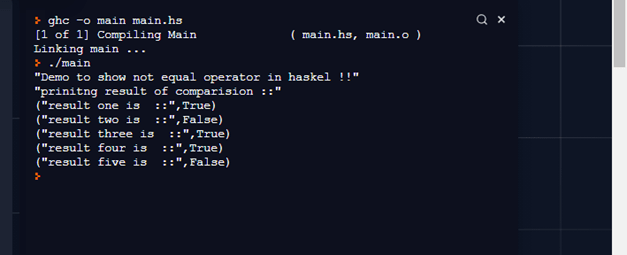Updated April 19, 2023

Introduction to Haskell not equal
not equal in Haskell is a comparison operator, which is used to compare the variable in the program whether they are equal or not. This operator is similar to the mathematical operator not equal, In Haskell, we have a different type of comparison operator which is used to validate the variable values, and according to the result we can execute our own logic in the program. In Haskell we use a symbol for not equal comparison, this symbol representation we will see in its syntax section of the tutorial. It is not a keyword but rather it is an operator in Haskell which return Boolean value based on the evaluation of the two variable. In the coming section of the tutorial, we will see its internal working and how to use this while programming, also its implementation in detail.
Syntax
To compare any variable in Haskell we use not equal operator from the comparison list of operators we have, these are inbuilt features of Haskell. Let’s take a look at its syntax for more detail and understand it better for usage see below;
symbol:
/=As you can see in the above line of syntax we have the ‘/=’ operator to compare the values in Haskell, it is easy to use. Let’s take a practice syntax by which we will have more clarity on how to compare two variable using not equal in Haskell see below;
Example:
value1 /= value2In this way you can use it in programming in Haskell, In the coming section of the tutorial, we will see the internal working of not equal operator, also the usage and its syntax in more detail with an example for beginners to understand it better.
How does not equal operator work in Haskell?
As of now we already know that not equal is used to compare the variables in Haskell. This is an operator that comes under the comparison operator list in Haskell. Also, as we have discussed that it is not a keyword that can be used directly by name, in order to use this while programming we have to use one symbol for it, after that only we will be able to compare the variable in the program. First, we will discuss the internal working of this operator then we will display the working through one flow chart diagram for this, it will give us a better understanding of the operator in details; Let get started;
1) Operator working; This operator is a comparison operator, with the symbolic representation, this operator is the opposite of equal operator in Haskell or any other programming language, in most of the programming language not equal is represented by the ‘!=’ this symbol but in Haskell, it has some different representation, which is more like the mathematical representation of “≠” this symbol they both represent the same thing not equal.
Representation and usage:
‘/=’: This is the basic representation of the not equal operator in Haskell, also it is an inbuilt feature provided by the Haskell language, so we do not require to include any library or external dependency for this to use this in the program. We can pass our variable or values direct at the left and the right side of the symbol and it will return us the result after the evaluation of both the values or variable.
Return Type: If we talk about its return type then it will always return us the Boolean value of True or False, based on the evaluation of the variable. If the values are not equal then it will return True, if the passed variable or values are equal then it will return us false. It works just opposite of the equal operator.
Type: This can be used to String, number, and character type in Haskell, we can compare these value by using not equal operator in Haskell. As we have known that it is very easy to use and handle. Also, it is very readable to the developers, but it has some different types of symbolic representation for it, which is very different than another language if we compare.
Flow chart
Now let’s take a look at its flow chart, how the internal flow goes when we try to use not equal operator, let’s take them to step by the stem which is as follows;
1) First we try to pass the variable which we want to compare. It takes two values to compare and return the result.
2) After this it will compare the values and return a Boolean value as result.
3) Equal: if the values passed is equal then the result is FALSE.
4) Not equal: If the values passed is not equal then the result will be TRUE.
5) The last step is an exit.
Below see the flow chart attached :
<image>
Examples
In the below example we are trying to compare the different values by using not equal operator in Haskell and printing the result.
Example:
main = do
print("Demo to show not equal operator in haskel !!")
let value1 = 100
let value2 = 200
let value3 = 300
let value4 = 300
let value5 = 150
let value6 = 10
let value7 = 300
let value8 = 400
let value9 = 50
let value10 = 50
print("prinitng result of comparision ::")
let result1 = value1 /= value2
let result2 = value3 /= value4
let result3 = value5 /= value6
let result4 = value7 /= value8
let result5 = value9 /= value10
print("result one is ::" ,result1)
print("result two is ::" ,result2)
print("result three is ::" ,result3)
print("result four is ::" ,result4)
print("result five is ::" ,result5)Output:
Conclusion
By the use of not equal, we can compare the values and perform the logic based on the result of the variable. This operator is very easy to use and handle, also does not require complex syntax to use this, also not external library handy to use anywhere in the program whenever it is needed.
Recommended Articles
We hope that this EDUCBA information on “Haskell not equal” was beneficial to you. You can view EDUCBA’s recommended articles for more information.


